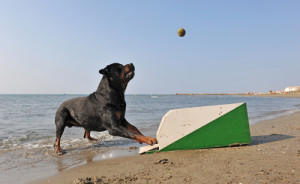 Think about your dog. What does he dream about? What would she do if you just sat down and watched her on a huge open field? What toy would he bring on an island if he could only bring one? Of course the answers will vary, but the vast majority will probably have something to do with running and tennis balls. For people, there might be an app for that; but for dogs, there’s a sport. We call this sport Flyball.
Think about your dog. What does he dream about? What would she do if you just sat down and watched her on a huge open field? What toy would he bring on an island if he could only bring one? Of course the answers will vary, but the vast majority will probably have something to do with running and tennis balls. For people, there might be an app for that; but for dogs, there’s a sport. We call this sport Flyball.
Flyball is as exciting as it sounds. It’s a relay race between two teams of dogs, down a straight line, over some hurdles, and to a box that pops a tennis ball out for them to bring back to you. More specifically, it’s a total of 51 feet from the starting line to the box. Six feet from the starting line is the first of four hurdles, placed 10 feet apart, with the box 15 feet after the last hurdle. The jump height is measured by the shoulder height of the smallest dog on the team. That’s why most Flyball teams have their signature “height” dogs. These dogs are called so because they set the height of the jumps for the entire team. While all dogs are valued, height dogs can be especially useful.
The relay race consists of teams of four dogs each. The dogs start at the same time, and the first team to finish wins that run. To complete a run, the dog must make all of the jumps, complete a box turn, and bring the ball all the way back to the handler. Only then can the next dog start. A box turn is typically equivalent to a Swimmer’s turn, in which your dog places all four feet on the box during the turn. Because each team can only have a qualifying score if all dogs complete their runs without any errors, the training is actually pretty important! Serious penalties are given for early starts and dropped balls during a run.
What started out as a fun social outlet for dogs and owners back in the 1960’s has since turned into a huge international sport. In fact, dogs have gotten so fast and so good, human perception has been pushed to the side by newer technology to get the most accurate times and scores. These electronic scoring systems are able to get the best readings and are typically used at all Flyball tournaments. In fact, most participants say they can’t imagine what it would be like to judge the sport without them!
Needless to say, these competitions come very close and have become enormous. There are both national and international competitions. The largest Flyball competition is held in North America by NAFA, the North American Flyball Association. In 2009, there were 300 teams competing over the three day event. That’s a lot of Flyball going on!
But you don’t have to be a huge competitor to have fun in the sport. In fact, Flyball was created as a way for dogs and their handlers to spend more time with each other and other dog enthusiasts. It’s enjoyable for everyone, and allows our dogs to burn off any excess energy both physically and mentally. And it’s not limited to registered purebreds like many other dog sports. Flyball encourages mixed breeds to come and play. The team holding the world record for the fastest run is even made up of a team of Staffordshire Terrier and Border Collie crosses!
So if you’re feeling bored and think your dog would like some more excitement in his life, and he has a love for running and tennis balls, Flyball will likely be your go-to sport. It’s very fun, very welcoming, and an excellent way to spend quality time with your pooch.
About the Author
Katie is a professional dog trainer located in Southern California, with a background of experience as a veterinary assistant as well. She has trained and competed with multiple breeds in AKC Obedience and Rally, agility, herding, Schutzhund/IPO, French Ring and conformation. She has been involved in dogs since she was a child, and specializes in protection dogs, working dogs, and aggression issues. You can visit her website, Katie’s Dog Training, to find out more information about her training and accomplishments. When she’s not helping others and writing, she’s out on the field with her Belgian Malinois and Pembroke Welsh Corgi.
 Think about your dog. What does he dream about? What would she do if you just sat down and watched her on a huge open field? What toy would he bring on an island if he could only bring one? Of course the answers will vary, but the vast majority will probably have something to do with running and tennis balls. For people, there might be an app for that; but for dogs, there’s a sport. We call this sport Flyball.
Think about your dog. What does he dream about? What would she do if you just sat down and watched her on a huge open field? What toy would he bring on an island if he could only bring one? Of course the answers will vary, but the vast majority will probably have something to do with running and tennis balls. For people, there might be an app for that; but for dogs, there’s a sport. We call this sport Flyball.
